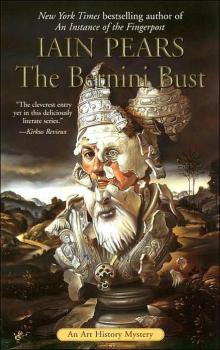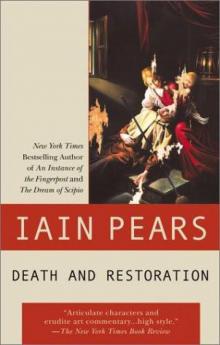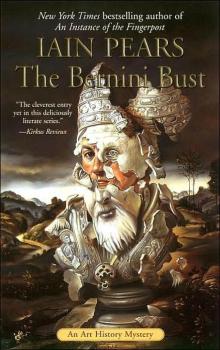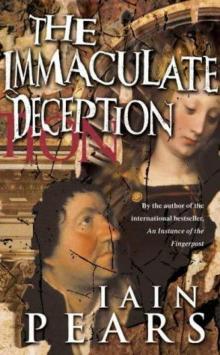- Home
- Iain Pears
The Raphael Affair
The Raphael Affair Read online
The Raphael Affair
Iain Pears
HarperCollins Publishers (1990)
* * *
First in the Italian art-history crime series featuring English dealer and sleuth Jonathan Argyll, from the author of the best-selling masterpiece 'An Instance of the Fingerpost'.
Flavia di Stefano is the kind of Italian beauty that art dealer Jonathon Argyll doesn't normally get to meet in his line of work. But, it turns out, all he had to do was get caught breaking into one of Rome's churches -- for Flavia is the Art Theft officer tasked with interviewing Jonathon. A strange way to meet, perhaps, but then Jonathon has an even stranger tale to tell.
His claim that the church contains a lost classic, hidden under another painting, is treated with cautious scepticism. But when the picture first vanishes, then turns up in the hands of a British art dealer claiming it's a newly discovered Raphael, it's clear there's more to it than meets the eye. When vandalism is followed by murder, it's up to Jonathan and Flavia to discover just how much...
Iain Pears
The Raphael Affair
HARPER
To Ruth
Table of Contents
Cover
Title Page
Author’s Note
1
2
3
4
5
6
7
8
9
10
11
12
13
14
15
16
Keep Reading
About the Author
Also by Iain Pears
Copyright
About the Publisher
Author’s Note
Some of the buildings and paintings in this book exist, others do not, and all the characters are imaginary. There is no National Museum in the Borghese Gardens, but there is an Italian art squad in a building in central Rome. However, I have arbitrarily shifted its affiliation from the carabinieri to the polizia, to underline that my account bears no relation to the original.
1
Generale Taddeo Bottando walked up the staircase covered in stolen works of art slightly before the bell of San Ignazio struck seven in the morning, as usual. He had turned up in the piazza a good deal earlier but, as was his habit, had passed ten minutes in the bar opposite the office drinking two espresso coffees and eating a panino filled with fresh ham. The habitués of the bar had greeted him as befitted a regular breakfast customer: a friendly ‘buon giorno’, nods of acknowledgement, but no attempt at any more conversation. Waking up, in Rome as in any other city, is a private matter that is best done in quiet solitude.
That pleasing early morning ritual over, he crossed the cobblestoned piazza and wheezed up the stairs, puffing and blowing heavily before he even finished the first flight. It was not that he was fat, so he reassured himself often. It was years since he’d last needed his military uniform let out. Portly, maybe. Distinguished-looking, he preferred. He should give up cigarettes and coffee and food and take up exercise instead. But what enjoyment would life have to offer then? Besides, he was nearing sixty, and it was too late now to start getting in trim. The effort would probably kill him anyway.
He stopped for a moment, partly to look at a new picture hanging on the wall, but more for a surreptitious opportunity to get his breath back. A little drawing by Gentileschi, by the look of it. Very handsome. Pity it would have to go back to the rightful owners when all the paperwork was done, the culprit charged, and the documentation sent over to the public prosecutor’s office. Still, it was one of the compensations of being the chief of the Italian National Art Theft Squad. On the rare occasions when you did recover something, it was generally worthwhile.
‘Pretty, isn’t it?’ a voice said behind him as he peered at the artist’s work. Suppressing the last remnants of his breathlessness, he turned round. Flavia di Stefano was one of those wonderful women that Bottando believed only Italy could produce. Either they became wives-and-mothers or they worked. And if they worked, they had to strive so hard to stave off guilt feelings about not staying at home that they were twice as good as anyone else. For that reason eight of the ten researchers were women. This, he knew, had caused his department to win an unfortunate nickname in other parts of the service. But at least Bottando’s Brothel, as his obviously jealous colleagues had dubbed his bureau, produced results. Unlike certain others he could mention.
He beamed a benevolent good morning at the girl. Or rather woman; he noted that he was now at an age when any woman under thirty counted as a girl. He liked her a great deal, even though she seemed totally unable to give him the deference to which his rank and age and wisdom entitled him. While some friends referred delicately to his certain roundness, Flavia called him, affectionately and without the least sense of shame, old tub. Apart from this, she was an almost perfect junior colleague.
Flavia, who also resolutely insisted on wearing sweaters and jeans to demonstrate that she fell into neither the policewoman nor serious businesswoman category, smiled back at his greeting. It was genuinely meant. In the last few years, the General had taught her an immense amount, mainly by leaving her alone to make mistakes, and covering for her afterwards. He was not one of those employers who see staff as a convenient herd of lambs to be sacrificed whenever something went wrong. Rather, he took immense pride in teaching his charges to do things properly and allowed them considerable, if always unofficial, independence. Flavia, more than most, had responded with enthusiasm and had become a full investigator in everything but name.
‘The carabinieri near the Campo dei Fiori rang and want to bring someone around,’ she told him. ‘They arrested him last night breaking into a church on their patch and they say he has an odd story to tell. They seem to think it is more in our line of business.’
She spoke in the harsh, nasal accent of the north-west. Bottando had hired her direct from the university at Turin, and she had abandoned a graduate degree to come to Rome. She always maintained that she would finish it eventually, and used this as her main reason for not joining the police fulltime. But she worked so hard in the department that it seemed very unlikely. She had the fair hair and light skin of many northern Italians. Even if she hadn’t been simply but definitely beautiful, her hair would have made her stand out in Rome.
‘Did they say what it’s about?’
‘No. Just something about a picture. They reckon he may be a bit crazy.’
‘What does he speak?’
‘English and some Italian. I don’t know how much.’
‘In that case you will have to talk to him. You know what my English is like. Let me know if he has anything interesting to say.’
Flavia made a mock salute, two fingers of her left hand pressed briefly against the fringe of meticulously disarranged hair that edged half-way down her forehead. Both of them wandered into their respective offices, she to the small, cramped one she shared with three others, he to the more luxurious one, decorated almost entirely with more stolen objects, on the third floor.
Bottando settled down and went through the morning ritual of going through the mail left on his desk in a neat pile by his secretary. Normal nonsense. He shook his head sadly, sighed heavily, and tipped the entire pile into the bin.
Two days later, a bulky document awaited him on his desk. It was the fruit of Flavia’s interrogations of the prisoner brought round by the carabinieri, and bore all the hallmarks of her conscientiousness. On top of it was a little note: ‘I think you’ll like this one – F.’ In principle, the interview should have been conducted by a full policeman, but Flavia had swiftly switched into English and gained control of the proceedings. As Bottando flipped through the pages
, he realised that the man clearly spoke Italian quite well. But the policeman on duty was fairly dull and probably would have missed almost everything of interest.
The document was a condensed transcript of the interview, the sort of thing that is sent along to the prosecutor’s office if the police think a case can be made. Bottando got himself an espresso from the machine in the corridor – he was an addict of many years’ standing who now could not even get to sleep at night without a last-minute caffeine fix – put his feet up and began to read.
For the first few pages there was little of any interest. The prisoner was English, aged twenty-eight and a graduate student. He was in Rome on holiday and had been arrested for vagrancy when found apparently trying to sleep in the church of Santa Barbara near the Campo dei Fiori. Nothing had been stolen and no damage reported by the parish priest.
All this took five pages, and Bottando was wondering why his department had been called in and why the carabinieri had bothered arresting him. Sleeping rough was hardly a major offence. Throughout the summer months, foreigners could be found snoring away on almost every bench and in every open space in the city. Sometimes they had no money, sometimes they were too drunk or too drugged to get back to their pensione, just as often there was not an empty hotel room for miles and they had no choice.
But as he flipped over the next page he became more interested. The prisoner, one Jonathan Argyll, informed the interrogators that he had gone to the church not to camp out, but to examine a Raphael over the altar. Moreover, he insisted on making a full statement because an enormous fraud had taken place.
Bottando paused. Raphael? The man clearly was off his head. He couldn’t remember the church very well but was convinced that he knew the location of every Raphael in the country. If there was one in a tiny little church like Santa Barbara, he would know about it. He walked to the computer and switched on. When the machine had hummed and whirred itself into readiness he went into the database that had been built up giving the locations of likely targets for thieves. He typed ‘Roma’, and, when it asked for more details, specified ‘chiesi’. He then typed in the name of the church. The machine instantly told him that Santa Barbara had only six objects that were potentially stealable. Three were bits of silver, one was a seventeenth-century vulgate Bible with an embossed leather binding, and two were pictures. But neither was a Raphael nor likely to be confused with one. Both, in fact, were very second-rate affairs that no thief worth his salt would waste his time stealing. The market for purloined, nine-foot by six-foot crucifixions by anonymous Roman painters was not exactly buoyant. Nor could he see much demand in the illicit international art trade for the altarpiece – a Landscape with the Repose on the Flight to Egypt by the magnificently mediocre eighteenth-century painter Carlo Mantini.
Going back to his desk, he read on for a few more lines, convinced that by ‘interesting’, Flavia merely meant that her document was yet another demonstration of the foolishness of mankind. She was very strong on this interpretation of human nature, especially as far as art collectors were concerned. Several times the department had abandoned the hunt for a minor work when they discovered that it had been bought – as a Michelangelo, Titian, Caravaggio or whatever – by a wealthy foreign collector with more money than sense. To get their revenge they wrote to the buyer informing him that he had been cheated, and passed on word to the local police. But, on the whole, they considered the humiliation the man would suffer was adequate punishment, and generally the work was too unimportant to go to all the trouble and expense of international arrest warrants and deportation orders.
So perhaps this fifty-page document simply catalogued the delusions of an unbalanced moron who had persuaded himself he could get rich quick? A few more glances rapidly persuaded him there was more to it than that. From being a question-and-answer session, the document settled into a sustained narrative, the result of a lengthy statement. Bottando read on, and became more puzzled:
‘…studying for a degree based on a dissertation about Mantini. During my research, I discovered a series of documents that proved beyond any doubt that Mantini earned money by working for art dealers in Rome in the 1720s and had taken part in a sizeable fraud. You mustn’t think that Italy’s restrictions on exports of works of art are new. Most old states had them even back in the sixteenth century. By the eighteenth century they were becoming onerous. The Papal States in particular were getting poorer, and lots of foreigners were coming here wanting to buy. So, various routes were worked out to bypass the regulations. The most usual was the most obvious: a series of judicious bribes. Pictures were also temporarily reattributed to some obscure painter, until an export licence was given. Occasionally, dealers would go so far as to cut the picture into fragments, ship it to London or Paris, then reassemble and repair it.
‘The more important the painting, the more difficult it was to get it out of the country. I suppose that is also true now. And the most difficult of all were those by – or thought to be by – the great triumvirate of the Renaissance: Raphael, Michelangelo and Leonardo. Several times dealers or collectors bought works by one of these artists, asked the papacy for permission to export, and were turned down. In many cases the pictures are still here. So, when the di Parma family wanted to sell their most valuable possession, something illicit was clearly needed if they were to collect the money.
‘The di Parmas had been a great family, one of the most powerful in central Italy. Like many others they had fallen on hard times, and when the Earl of Clomorton offered to buy their Raphael for an outrageous sum they agreed. To get it out of the country, they enlisted the aid of an English art dealer called Samuel Paris, and he turned to Mantini for extra assistance.
‘The routine they came up with was beautifully simple. Mantini was to paint over the Raphael and the picture was to leave the country as one of his works. When it got to England the new painting would be cleaned off and the Raphael would take its place in the Earl’s collection. Presumably Mantini used a coat of varnish to protect the painting underneath, and used only paint that could be removed easily.
‘I don’t know any of the details of how it was done technically, but I do know it was done. There is a letter in the Clomorton archives from Paris assuring the Earl that he had watched Mantini apply the paint and seen the Raphael disappear under its disguise. But Clomorton never hung his picture on his wall.
‘At some stage something went wrong, either accidentally or deliberately. The picture must have been switched; the payment for the Raphael was handed over and a different picture was sent to England. Shortly after it arrived, the fraud was evidently discovered and the Earl died. The family doesn’t seem to have mentioned the matter again.
‘The point is, the Raphael was covered by Mantini – this was seen by Paris; it never got to England; and it disappeared from the di Parma collection. On the other hand, the family owned a Mantini in 1728 that they hadn’t had four years earlier.
‘Now, all of this suggests that the Raphael stayed in Rome under cover. If that was the case, I don’t know why they never wiped the disguise off. But they didn’t, the Mantini stayed in the collection and was evidently considered to be of such small importance that in the 1860s they donated it to Santa Barbara as an altarpiece.
‘And there you are. The picture has rested unknown in that church for more than a century. I first saw it a year ago when I was working on my dissertation. Then I decided a Raphael may be underneath, came back to check, and it’s gone. Someone has pinched the damn thing.’
Even when seen through the stilted prose of an official document, the prisoner’s sense of outrage was clear. Not only had he been jilted out of one of the most remarkable art discoveries of the decade, he had got himself arrested as a vagrant to boot. If, indeed, it was a remarkable discovery. Either way, if the painting had vanished, it was something to look into. Seeing an excuse for a stroll, he summoned Flavia, walked down the stairs, and set off for Santa Barbara.
One of the
delights of his job, so Bottando thought to himself as they walked, was the chance of living in Rome. Although not born here, he considered himself very much a Roman and had spent most of the past thirty years in the city. Much of his dislike of his previous assignment in Milan had been prompted not by the job, but because he had had to live in a city which he regarded as soulless and drab.
Then came his great opportunity. Bottando was summoned back to Rome to combat the growing number of thefts of works of art throughout Italy. The creation of his department was due to the theft of a dozen famous works from one of the best – and theoretically best guarded-museums in the country. The police, as usual, hadn’t known where to start. They had no contacts in the art world, didn’t know the likely instigators, hadn’t a clue what might have happened to the paintings.
In a country where the love of art is part of national identity, the matter quickly bubbled up into a potential scandal once it had been raised. The smaller political parties in the ruling coalition began making speeches about defending the national heritage from rapacious foreigners as a way of irritating the larger group of Christian Democrats. At one stage, it had even seemed as though the socialists would pull out of the coalition, and that love of art would bring down the government – thus giving the country another unusual political first.
But it didn’t happen. The polizia, spotting a way of aggrandising itself at the expense of the rival carabinieri, proposed a national task force to combat the problem, and for once were backed up by their minister. And in due course they had chosen Bottando to run it, the call to duty rescuing him from the drudgery of fighting an unequal and losing battle against white-collar criminals and other semi-legitimate hoodlums in the financial waters of central Milan.

 The Dream of Scipio
The Dream of Scipio Stone's Fall
Stone's Fall The Last Judgement
The Last Judgement An Instance of the Fingerpost
An Instance of the Fingerpost The Bernini Bust
The Bernini Bust Arcadia
Arcadia Death and Restoration
Death and Restoration The Raphael Affair
The Raphael Affair The Titian Committee
The Titian Committee The Immaculate Deception
The Immaculate Deception Giotto's hand
Giotto's hand The Portrait
The Portrait The Bernini Bust ja-3
The Bernini Bust ja-3 Death & Restoration ja-6
Death & Restoration ja-6 The Immaculate Deception ja-7
The Immaculate Deception ja-7